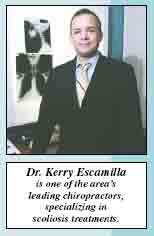
|
|||||||||
|
|||||||||



|
|
Frequently Asked Questions
How do I know if I have scoliosis?
How do I know if I have scoliosis?
Scoliosis or curvature of the spine commonly produces a cosmetic deformity. Visible asymmetries in the contour of the back and the observation that one shoulder or hip is higher than the other are the most common signs that someone has scoliosis. These asymmetries are more pronounced in adolescence during rapid growth spurts and may be detected by parents or friends.
Is Chiropractic care utilized in treatment of scoliosis? An important advantage a chiropractor has when treating scoliosis is identifing vertebral misalignments in the spine called "Subluxations". Subluxations can result in nerve interference, altered joint sensitivity and posture awareness, arthritis and pain. Chiropractic care during and after bracing is an added dimension not available with other approaches. Is there someone I can talk to who has scoliosis? Discovering that you have scoliosis may be frightening. Once patients understand that curvature of the spine is not rare (approximately 3% of the population has a curve of 10° or more), they accept being followed by a qualified physician to monitor the curvature for progression. Information about scoliosis and its many variants is readily found in bound reference material and on the Internet www.eSpine.com/scoliosis2.html The primary source of information on scoliosis and curvatures of the spine should be obtained by a qualified orthopedic spine surgeon. Many patients find that speaking to a similar aged individual who is also dealing with scoliosis can be comforting. Is scoliosis caused by not drinking enough milk or eating too much junk food? In extremely rare cases, scoliosis can be caused by dietary issues. Scoliosis may be an infrequent finding in diseases where calcium is lacking which causes softening of the bone. What one eats and how much one eats does not produce curvature of the spine. To my knowledge, junk food by itself has never caused curvature of the spine. Children and adolescents who have scoliosis rarely complain of pain. If pain is the major complaint in a young patient with scoliosis, further analysis is needed beyond plain x-rays to establish an underlying cause of the curvature. For example, in rare instances a benign inflammatory focus of tissue (osteoid osteoma) can produce curvature of the spine. To answer this question it must be understood that scoliosis falls into two major categories: idiopathic and non-idiopathic scoliosis. Idiopathic is the more common type of scoliosis and the one that is most commonly identified at the beginning of accelerated growth in adolescence. Unfortunately, at this time we have not established a single identifiable cause for production of curvature of the spine in idiopathic scoliosis. I have the honor of being a member of an international group of physicians who have received grants from the Cotrel Foundation of France to investigate the causes of idiopathic scoliosis. To date, research has focused on genetics (based on the observation that scoliosis can run in families), nerve and muscle abnormalities (based on the observation that scoliosis can occur in patients who have abnormalities of the nerves and muscles), central mechanisms and abnormalities of the inner ear. My research focuses on the finding that the fluid around the spinal cord (CSF) flows asymmetrically in patients that have curvature of the spine. That research is being carried on here at the Cedars-Sinai Institute for Spinal Disorders in Los Angeles. To read more about this research project, please click here. |
 |








